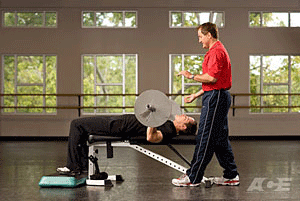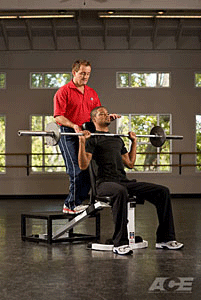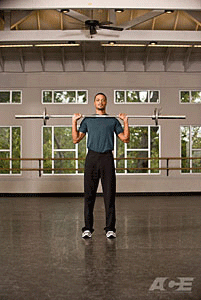Barbell Bench Press |
readmore »
Step 1
Starting Position: Lie on your back on a flat bench or raised platform with your feet firmly on the ground, your spine in neutral position. Position yourself on the bench so the bar is directly over your eyes. Pull your shoulder blades down and back so that they make firm contact with thebench. Your head, shoulders, and butt should make contact with the benchand your and feet should make contact floor throughout the exercise. Grasp the bar with your palms facing forward and your thumbs wrapped around the barbell.
Step 2
Signal your spotter for assistance in moving the bar to your starting position. Once the bar is unracked, position the bar over your chin or upper chest with your elbows straight. Keep your wrists in a neutral position.
Step 3
Downward Phase: Inhale. In a slow and controlled manner, lower thebarbell to lightly touch the middle of your chest - just below the armpits. The wrists should remain in neutral and your forearms vertical to the floor. Do not allow the back to arch away from the bench. Maintain all points of contact with the bench and keep your feet firmly on the floor/riser throughout the exercise. Performing the exercise with the elbows close to your sides emphasizes more triceps. Performing the exercise with the elbows flared out from the body emphasizes more pectorals.
Step 4
Upward Phase: Exhale and gently press the bar up to straighten the elbows taking the bar to the original starting position with the bar positioned over your chin or upper chest. Do not allow the back to arch away from thebench. Maintain all points of contact with the bench and keep your feet firmly on the floor/riser throughout the exercise.
Step 5
At the end of the set, signal your spotter to assist you in taking the barbelland maintain a firm grip until the bar is racked.
Safety is very important in this exercise. A spotter should adopt a split-stance position, standing erect with an alternating grip position (one palm facing upwards and one facing downwards) positioned inside the exerciser's hand position. Keep the hands close to the bar, but not touching the bar unless needed.




